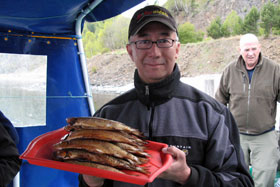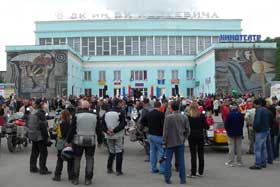Siberia (Sibir in Russian) is truly one of the world’s last frontiers. Roads are few, and in such poor condition that I couldn’t imagine navigating them on anything other than a GS motorcycle. The small, agrarian villages that exit look all essentially the same, tiny homes made from squared-off logs, with few windows in an attempt to keep the fierce winds and biting cold of the winters here at bay. Heating is by wood. Many homes don’t have running water, and it is not uncommon to see people filling jugs and containers at a community pump.
The landscape is a flat expanse dotted with forests of birch, with stands of evergreens making a periodic appearance. Smack in the middle is Lake Baikal, which, it is claimed, holds more fresh water than all of America’s Great Lakes combined. Were it located anywhere but in Sibir, its accessible shores would be a continuous resort-opolis of condos and motels. Instead, due to its isolation, there is a single pulp mill, and only two small towns of any merit.
With nothing but plains and forests surrounding us for days on end, it’s no wonder that an excursion on Baikal is one of the highlights of our journey across this part of Russia. However, with the long riding days, and need for laundry and maintenance on our few “layover days”, this year, only a few us of joined the crew of our chartered boat for our bi-annual cruise along the shores of Baikal.
In 2006, a good portion of the Lake was covered with floes of broken ice. This year, the ice had melted, but it was a cold and windy day nonetheless. One trip below decks, which consisted solely of the engine room and a bunk house fitted with four small hanging cots, quickly convinced us that we would stay topside. A wind shelter of tarps had been rigged around the stern, but of course, this set-up could only shield us from the breeze if the boat were in reverse. . . .
We headed out onto 32,000 square kilometers of water, which at times reaches over 1,650 meters (5,300 feet) in depth. The shoreline is 2,100 kilometers (1,300 miles) in length. At the museum we visited before boarding, we were told there are over 1,000 species of plants, and half-again as many varieties of animals, almost 80% of them unique to the area. All we see is water, very cold water. At its greatest length, the Lake is 630 kilometers (390 miles) long.
With such a small group, we are on one of the smaller tourist boats that ply the Lake. At one time, these craft, built here on the shores, carried timber to railheads, but logging companies have taken to land, and these haulers have all converted to the tourist trade. Our boat seemed sturdy enough, though an alarming clank of metal on metal resounded below decks whenever the engine was spun to cruising speed. The wheelhouse was decked out in a leopard motif, and was equipped with both a massive (and non-functional as it turned out) ancient, hooded Russian radarscope, and new (and wholly functional) state-0f-the-art Garmin GPS receiver (similar to what we have on all our bikes).
We made turns out of Lisvtyanka, and headed for one of the few accessible “beaches” along the near shore. While the group explored the woods and an old train tunnel, the crew hot smoked one of the few fish of any commercial value caught in the lake, the famous Baikal Ohmul. In a surprisingly short amount of time, a tray of this smoked whole-fish delicacy found its way to the “dining area” on the fantail, and a picnic-style repast, with a good bottle of Baikal Vodka to take the edge off the cold, made for a welcome dinner.
Wrapped up in blankets, we weathered our way back to our dock. Needless to say, this year, no one took the plunge into the lake itself, regardless of the local belief that a swim in Baikal will make you 25 years younger.

MikeP
|

























